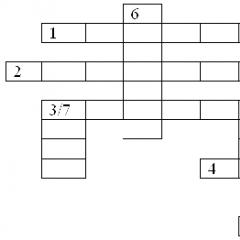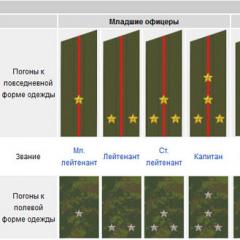Russian State Technological University named after K.E. Tsiolkovsky (mother). Russian State Technological University named after. K. Tsiolkovsky International Space University named after K. Tsiolkovsky
The history of the creation of MATI is connected with one of the brightest and most romantic pages of domestic aeronautics - the design, construction and operation of airships.
Early 30s...
Soviet airship construction begins to develop. In 1932, the aeronautical department of the Moscow Aviation Institute was reorganized into the Airship Construction Institute. But a year later, it was decided to unite all aeronautical departments of other universities in the country into a single training center for the young industry - the Airship Training Combine (DUK), which, in addition to the institute, also included an aeronautical school.
In the early 40s, airplanes finally supplanted airships and completely conquered the skies. In order to train personnel for the developing aviation industry, on June 17, 1940, by a joint decision of the Council of People's Commissars of the USSR and the Central Committee of the All-Union Communist Party of Bolsheviks, on the basis of the Moscow Institute of Civil Air Fleet Engineers named after. K.E. Tsiolkovsky, the Moscow Aviation Technological Institute (MATI) was created with three full-time faculties: hot and cold metal processing, aircraft engine technology, and aircraft technology.
During the reorganization, the name K.E. Tsiolkovsky was not assigned to the newly created institute. During the Great Patriotic War MATI not only did not interrupt the training of aviation engineers that the country desperately needed, but also actively developed. So, during the years of evacuation (1941-1943) in Novosibirsk, the following departments were created at MATI: “Foundry Technology”, “Technology of Processing of Non-Metallic Materials”, “Technology of Metal Forming”.
2009– the Institute of Military Training was created, which included the Faculty of Military Training and the Military Training Center.
2009– the Resource Center for Collective Use “Aerospace Materials and Technologies” was created on the basis of MATI.
2011– the current name Federal State Budgetary was assigned educational institution higher vocational education“MATI – Russian State university of technology named after K.E. Tsiolkovsky."
2012– the following departments were created: “Technical regulation and quality assurance of special-purpose products” on the basis of Rosoboronstandart and “Technological assurance of the reliability of aircraft manufacturing products” on the basis of JSC UAC.
INSTITUTIONS
No. 1 Materials Science and Materials Technology- No. 2 Aerospace structures, technologies and control systems
- No. 3 Information systems and technologies
- №4 Management, economics, and social technologies
- Institute of Military Training
- Institute Distance learning
- Stupino branch
Faculties:
- Faculty No. 1 “Aviation Technology”
- Faculty No. 2 “Aerospace structures and technologies”
- Faculty No. 3 “ Information systems and technology"
- Faculty No. 4 “Materials Science and Technology of Materials” named after. B.S. Mitina
- Faculty No. 5 “ Applied Mathematics, mechanics and computer science”
- Faculty No. 6 Engineering and Economics named after. V.B.Rodinova
- Faculty No. 7 Institute of Youth Policy and Social Technologies
Stupino branch of MATI Institute for the Development of New Educational Technologies
- Institute electronic forms training
- Institute of Military Training
- Faculty of Advanced Studies
- Resource center for collective use "Aerospace materials and technologies"
MINISTRY OF EDUCATION AND SCIENCE OF RUSSIA
Federal State Budgetary Educational Institution of Higher Professional Education
"Mati - Russian State Technological University named after K.E. Tsiolkovsky (mother)"
Department of Economics and Management
Industrial practice report
IN SF "MATI - RGTU named after. K.E. Tsiolkovsky"
at the Department of Economics and Management
Student 4th course 14MEN-4DS-030 groups
Yakovlev Vadim Vadimovich
Head of practice
from the enterprise Alexandrova A.V.
Head of the Department of Economics and Management(signature)
Head of practice
from the university Sigalin Yu.A. (signature)
Stupino 2013
|
INTRODUCTION…………………………………………………………………… CHAPTER 1. ORGANIZATIONAL AND ECONOMIC CHARACTERISTICS OF “MATI – RGTU IM. K.E.TSIOLKOVSKY". 1.1. History of the formation and development of MATI………………………………. Organizational and legal basis for functioning "MATI - RGTU named after. K. E. Tsiolkovsky"……………………………… 1.3. Results of planning and financial activities of MATI……………………… CHAPTER 2. FORMATION OF INNOVATION POLICY OF THE UNIVERSITY………………………………………………………………………….... CONCLUSION………………………………………………………………. LIST OF SOURCES AND REFERENCES USED. Appendix 1. Organizational structure MATI………………………... Appendix 2. MATI goal tree……………………………………….... |
Introduction
Innovative education involves learning in the process of creating new knowledge - through the integration of fundamental science, directly educational process and production.
The purpose of the internship is to become familiar with the work of MATI and its functioning. This goal is divided into several tasks:
1. Characterize MATI - consider and describe the historical, organizational and legal aspects of its functioning;
2. According to the individual assignment, develop recommendations for the formation of its innovation policy.
The object of the internship is the Federal State Budgetary Educational Institution of Higher Professional Education "MATI - Russian State Technological University named after K.E. Tsiolkovsky".
The subject of practice is innovative management of a higher educational institution.
In the process of writing the report, the following information sources were used: Federal Law No. 12-FZ “On Amendments and Additions to the Law Russian Federation“On Education”, Federal Law No. 125-FZ “On Higher and Postgraduate Professional Education”, Charter of the Federal State Budgetary Educational Institution of Higher Professional Education “MATI - RGTU named after K.E. Tsiolkovsky (MATI)", official website of the Ministry of Education and Science of the Russian Federation, official website of the Federal State Budgetary Educational Institution of Higher Professional Education "MATI - RGTU named after K.E. Tsiolkovsky (MATI)". The works of such authors as:
Shvander V.A. and Gorfinkel V.Ya., Surin A.V. and Molchanova O.P.
Chapter 1. Organizational and economic characteristics of “Mati-RGTU named after. K.E. Tsiolkovsky"
History of the formation and development of mother
The history of the creation of MATI is connected with one of the brightest and most romantic pages of domestic aeronautics - the design, construction and operation of airships.
The beginning of the 30s... Soviet airship construction begins to develop. In 1932, the aeronautical department of the Moscow Aviation Institute was reorganized into the Airship Construction Institute. But a year later, it was decided to unite all aeronautical departments of other universities in the country into a single training center for the young industry, the Airship Training Combine (DUK), which, in addition to the institute, also included an aeronautical school.
At the same time, the DUK team established close creative ties with the famous aeronautics and astronautics theorist Konstantin Eduardovich Tsiolkovsky. He closely monitors the development of the new institute and actively contributes to the formation and development of its methodological and material base.
Therefore, it is no coincidence that after the death of the scientist, in order to perpetuate his memory, on October 20, 1935, the Moscow Airship Training Plant was named after K.E. Tsiolkovsky.
By the end of the 30s, the production of airships gradually gave way to aircraft construction. Therefore, in 1939, the Airship Construction Training Plant was reorganized into the Moscow Institute of Civil Air Fleet Engineers named after K.E. Tsiolkovsky. He trained engineers in the following specialties: airship construction and operation of airships, aircraft and their repair, aircraft engines and their repair.
In the early 40s, airplanes finally supplanted airships and completely conquered the skies. In order to train personnel for the developing aviation industry, on June 17, 1940, by a joint decision of the Council of People's Commissars of the USSR and the Central Committee of the All-Union Communist Party of Bolsheviks, on the basis of the Moscow Institute of Civil Air Fleet Engineers named after K.E. Tsiolkovsky, the Moscow Aviation Technological Institute (MATI) was created with three full-time faculties: hot and cold metal processing, aircraft engine technology, and aircraft technology.
In the post-war period, the development of MATI is characterized by a significant expansion of the range of specialties in which students are trained, the formation and development of its own scientific schools, and the establishment of broad scientific and public contacts with domestic and foreign partners.
1946 - a faculty was created in Stupino, Moscow region, later transformed into the Stupino branch of MATI.
1953 - the pioneer camp "Zvezdny" was built and put into operation in the Shchelkovsky district of the Moscow region (now the Educational and Sports and Health Center "Zvezdny").
1962 - the Faculty of Radioelectronic Equipment was opened (now Faculty No. 3).
1963 - the Faculty of Advanced Training for Managers and Engineering and Technical Workers began to function; The institute received the right to accept doctoral dissertations for defense.
1976 - the Faculty of Advanced Training for University Teachers was founded.
The stage of dynamic transformation of MATI into the largest university center is associated with the name of its rector, professor, doctor of technical sciences, laureate of state prizes, president of the Association of Engineering Education of Russia Boris Sergeevich Mitin.
B.S. Mitin showed outstanding organizational skills, which allowed MATI to become one of the leading universities in Russia. He established and intensively strengthened the university’s ties with largest enterprises aerospace industry, opened MATI to broad international cooperation, ensured the preservation and enhancement of the university’s traditions, initiated and organized the construction of a new MATI complex in Kuntsevo. During this period:
1979 - the department of “Powder and composite materials and protective coatings” was created under the leadership of B.S. Mitina.
1979-1989 - branches of the leading graduating departments of the institute were organized at the Lianozovsky Electromechanical Plant, the Moscow Institute of Electromechanics and Automation, the All-Union Institute of Light Alloys, the Moscow Machine-Building Plant "Experience", the Balashikha Foundry-Mechanical Plant, the Moscow Machine-Building Plant named after. A.I. Mikoyan, MALO named after P.V. Dementyev, Institute of Metallurgy of the USSR Academy of Sciences, CIAM named after. P.I. Baranov, "Tsentrolit" plant.
1983 - the Council for Career Guidance and Admission to the Institute was created.
1984 - the Faculty of Technology of Aircraft Structures Made of Composite Materials was created.
1986 - construction of a new complex of university buildings in Kuntsevo began.
1989 - the Interindustry Institute for Advanced Training of Personnel in new areas of engineering and technology development was created; faculty organized pre-university training and professional guidance.
1991 - MATI began training foreign students.
1993 - MATI was given the status of a university and the name Moscow State Aviation Technological University named after K.E. Tsiolkovsky; The Faculty of Applied Mathematics and Information Technologies was created.
1994 - the Faculty of Economics was organized.
1995 - the Russian-British Aerospace School was organized jointly with Kingston University (UK).
1996 - by order State Committee of the Russian Federation for Higher Education dated July 11, 1996 No. 1216 MATI named after K.E. Tsiolkovsky was renamed “MATI” - Russian State Technological University named after K.E. Tsiolkovsky.
2002 - capital construction was completely completed and the first stage of the complex of educational and administrative buildings in the Kuntsevo district of Moscow was put into operation. Construction of zone 2 “B” of the second stage of construction of a complex of buildings on this territory has also resumed.
2003 - in accordance with the decision of the Academic Council of MATI and the order dated December 8, 2003. No. 4514 The Ministry of Education of Russia created the Institute of Youth Policy and Social Technologies at the university.
2004 - design has been completed and work has begun on the construction of a complex of outdoor sports facilities on the territory of a complex of educational and administrative buildings in the Kuntsevo district of Moscow.
About the university
* June 17, 1940 by a joint decision of the Council of People's Commissars of the USSR and the Central Committee of the All-Union Communist Party of Bolsheviks on the basis of the Moscow Institute of Civil Air Fleet Engineers named after. K.E. Tsiolkovsky, the Moscow Aviation Technological Institute (MATI) was created. In 1973 MATI was again named after Konstantin Eduardovich Tsiolkovsky. By order of the State Committee of the Russian Federation on higher education dated July 11, 1996 No. 1216 MATI named after K.E. Tsiolkovsky was renamed “MATI” - Russian State Technological University named after K.E. Tsiolkovsky.
* The founder of "MATI" - Russian State Technological University named after K.E. Tsiolkovsky is Federal agency by education.
* Activities in the field of education and science are carried out on the basis of:
- state license for the right to carry out educational activities dated April 3, 2007 No. 8684;
- certificate of state accreditation dated May 4, 2007 No. 0610;
* The university implements educational programs higher professional education in 16 areas of training for bachelors and masters, 24 specialties of higher professional education, trains highly qualified scientific and pedagogical personnel in 28 scientific specialties, retraining and advanced training in programs of various profiles and duration of development.
* Currently, more than 12,000 students and about 400 graduate students are studying at MATI. Implementation of educational programs, scientific research carried out by more than 200 doctors and more than 450 candidates of science.
* A branch of the university in the city of Stupino, Moscow region, was formed through the reorganization of the evening faculty of the Moscow Aviation Technological Institute (Stupino) carried out in accordance with the order of the MB and SSO of the RSFSR dated June 6, 1966 No. 315. Renamed on the basis of an order of the Ministry of General and Professional Education of the Russian Federation dated December 28, 1998 No. 3254 to the Stupino branch of “MATI” - Russian State Technological University named after K.E. Tsiolkovsky. The branch carries out educational activities for full-time and part-time education in accordance with the license issued by the Ministry of Education of Russia dated April 1, 1999 No. 024G-0425. The university branch implements educational programs of higher professional education in 4 specialties of higher professional education. Almost 1,000 people study in the branch’s day and evening departments.
* Together with Kingston University (UK), MATI, the Russian-British Aerospace School was created, operating under a system of exchange of student groups. The school has been successfully operating since 1995. During the implementation of this project, MATI completed a specialized educational training over 250 European students, similar number Russian students visited leading technical universities and aerospace enterprises in the UK.
* The university has extensive, long-term relationships with a number of foreign universities And scientific institutions in the field of education, scientific research, organization of personnel exchanges, joint creation teaching materials. Every year, MATI masters higher professional education programs of various levels and directions, specialized educational programs, and more than 300 foreign students and specialists undergo internships. Today, students from 17 countries study at the university. Currently, MATI has permanent partners in such countries as the Republic of South Korea, Great Britain, Holland, the Islamic Republic of Iran, the Union of Myanmar, and the Socialist Republic of Vietnam.
* MATI is one of the organizers of the World Aerospace Congress, the organizer of the annual International Youth Scientific Conference “Gagarin Readings”, which has been held for more than 30 years.
* MATI is the head university of the Educational and Methodological Association for Education in the field of materials science and technology of materials and coatings (UMO MTMP).
Accreditation, No. 1304 May 4, 2012
Russian State Technological University named after K. E. Tsiolkovsky was founded in 1932. It is named after the great Russian scientist Konstantin Eduardovich Tsiolkovsky
Faculty of Aerospace Design and Technology
The Faculty of Aerospace Design and Technology is a unique faculty of this university. There are very few universities in the country that produce specialists in the aerospace industry. And in the age of digital technology and the conquest of space, the country needs specialists who will allow Russia to maintain its leading position in space. MATI trains space engineers in many specialties. MATI graduates are engaged in space telecommunications, design, creation and testing aircraft, design of life support systems space stations, the problem of ultra-long-range flights and calculations of launching satellites into orbit and their trajectories.
International cooperation
MATI gladly welcomes students from other countries within its walls. This university also has staff foreign teachers who exchange experiences with Russian colleagues. All conditions for studying and equal opportunities have been created for students both for Russian children and for foreigners who want to study in.
Russian State Technological University named after K. E. Tsiolkovsky actively cooperates with foreign institutions and companies in the field of development and design of various devices and their control systems. Since the aerospace sector is very dependent on the materials available for construction, MATI actively cooperates with both Russian and foreign universities in the metallurgical and composite fields. To accurately calculate and model the behavior of aircraft in both air and airless environments, MATI collaborates with the world’s leading scientists. The aerospace sector must be equipped with the latest developments in materials science, aerodynamics, kinetics, and digital technologies.
Student life
It is extremely important for students to have not only modern classrooms equipped with the latest educational technology, but also have places for leisure and sports. The management of the institute perfectly understands the needs of students and meets them. The MATI administration has provided its students with a huge sports complex that can accommodate everyone who wants to play sports and keep their body in good shape. There is also a cultural center for students, where student holidays and various events are constantly held. The Institute holds beauty contests, KVNs and other entertainment events.



